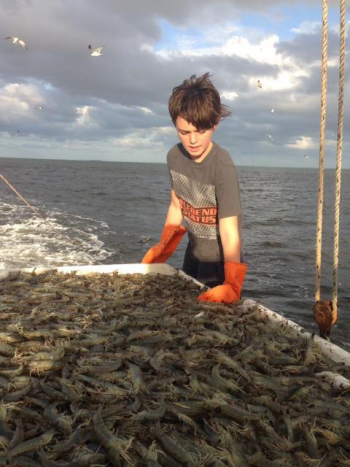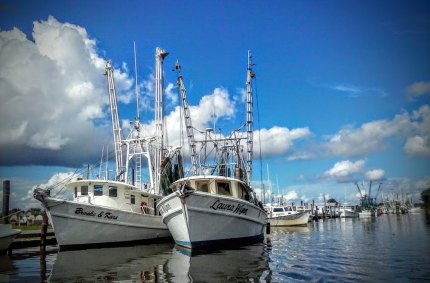Truths About Trawl Life

In the name of environmental stewardship, a non-profit group based in Raleigh and Charlotte has aimed their fire at the state’s commercial fishermen. Stakeholders say this effort could ultimately shut down a historic industry.
According to their website mission statement, NC Wildlife Federation (NCWF) is a 501c3 non-profit organization that “has worked for all wildlife and habitat bringing together citizens, outdoor enthusiasts, hunters and anglers, government and industry to protect North Carolina’s natural resources.”
Their latest conservation effort is aimed towards a fishery that brings one of our state’s highest prized commodities to the table - fresh NC shrimp. Contrary to their mission statement, the NCWF has not brought together citizens in this effort, nor have they based their claims on industry facts. Calling the trawling industry “killers,” they’ve petitioned the Marine Fisheries Commission (MFC) to drastically change rules for the fishery. Folks in the business of fresh seafood say these cuts will take fresh NC shrimp off the table for good.
“Basically, the impact of this petition will be to shut down the NC shrimp industry,” said Jerry Schill, president of NC Fisheries Association.
The 99-page petition, submitted by NCWF on November 2 to the MFC, calls for drastic rule changes for the trawl fishery, including day-time only fishing, strict gear limitations and the most extreme - reclassifying NC waters (including three miles into the ocean) as secondary nursery areas. The designation would lead to closing all waters to trawling, namely shrimping. The NC Fishery Association estimates the commercial industry would see a decline in shrimp landings upwards of 70 percent in the first year alone.
Fisheries advocates with NC Catch have compiled facts, complete with sources cited, to educate the public on some of the misrepresentation. This information, along with a host of benefits that come with enjoying fresh, local seafood can be found on their website, nccatch.org.
NCWF calls trawl gear “walls of death,” asserting that “shrimp and anything else entering the opening of the net are captured.”
Just by identifying trawl gear and the method of fishery, this can be proved false. According to info from NC Catch, North Carolina was the first state to pioneer a gear type called “finfish excluder,” which, excludes as much as 70% of the juvenile finfish during a tow. In addition, NC trawlers are required to use Turtle Excluder Devices (TED) to allow sea turtles to escape. TED’s can also exclude significant amounts of juvenile finfish.
Again failing to recognize the gear and how it works, the NCWF charges that “trawls are recognized as highly destructive, nondiscriminatory killers.” While scientists do acknowledge that trawls can be harmful to structured sea bottom, the industry says that structured bottom can also be dangerous to trawler nets and gear. A captain with local smarts will stay away from what they call “hangs” (oyster rocks, debris and structured bottoms), as these obstacles can tear up nets and gear, forcing the crew to make repairs. Whether mending nets onsite or going back to the docks to do some welding, they will miss precious fishing time. Proving to be stewards to their trade, many trawl boaters often make sure to deck any “hangs” (debris), removing them from the sound to prevent future problems.
Furthermore, since most of the Pamlico sound is soft bottom of sand and/or mud, NC Catch points to science that says trawling disturbance can actually stimulate an increase in the population of bottom invertebrates in this type of environment. And while there is evidence of bottom-disturbing gear used in the sounds, the NC Catch info says scientists compare this to “harsh winter storms with short-term impacts.”
Still, NCWF asserts that ”there are no direct studies by the North Carolina Division of Marine Fisheries on the subject.”
That couldn’t be further from the truth.
In fact, charges NC Catch, our state leads the way in exemplary fisheries data collection and has received state and national recognition for efforts that have spanned nearly 40 years. Not only did NC pioneer the finfish excluder (and require it be used) some 20 years ago, but we’ve garnered extensive data on species most commonly found in trawl bycatch (spot, croaker and weakfish) since 1978. And according to this DMF data, spot and croaker are not classified as overfished. Data determined that weakfish, although classified as depleted stock, is not on the decline due to overfishing.
“Arguably, the most destructive gear used in N.C. is the trawl” and “trawl doors as wide as a Caterpillar tractor blade are used,” claims NCWF.
Again, the NCWF, are obviously not educated on trawling gear. (see photo)
To harvest shrimp, trawl “doors” are wooden mechanisms (resembling doors) that are chained above the construction of the net, scooping up morsels in the water column, not in the sand or mud. The doors are designed to float along the seafloor, guiding the net behind it. As the trawl boat steams slowly along dragging nets with her outriggers down (the metal arms on either side), interaction with the seafloor is not ideal for several reasons - to maximize catch, keep gear in working order, maximize fuel costs and to safely navigate. A hard snag on one side of the vessel could result in injury to the crew or even cause the boat to capsize. Also, the size of the trawler must be taken into consideration. According to NC Catch, the majority of trawlers that work the internal waters of NC are less than 40 feet - thus the smaller the boat, the smaller the equipment.
Which brings to another untruth touted by NCWF. They blatantly dismiss the far-reaching economic effects of their proposed rules on trawling, claiming mere hundreds, maybe thousands will be impacted and that most trawlers in our state are owned by large corporations. One could disprove the large corporation theory just by taking a drive down to the coast and seeing these small, family owned operations. The environment is anything but corporate. Looking around the fish houses in Swan Quarter, Cedar Island, Oriental or Varnamtown (to name a few) , it’s easy to see the captains and crews, the dock hands, the shrimp-headers, the office help and the freight drivers all represent a large chunk of the coastal economy. Understanding that most have mouths to feed at home, it is certain that the economic impacts of closing down this industry will reach well beyond thousands of North Carolina citizens.
But the effects are more far reaching than the fish house. Beyond those that work directly in the commercial fishing industry, taking locally caught shrimp from our tables would have a huge impact on NC tourism - an industry that has been an economic hero for distressed coastal communities. In 2015, the Outer Banks Visitors Bureau reported a total of $236,779,616 spent on restaurant meals in Dare County alone. And it’s safe to say that seafood is one of the first culinary choices for those visiting the coast. Taking seafood away from visitors would be like taking the sand from the beaches. The experience just wouldn’t be the same.
The lack of economic impacts cited in the petition could mean that the petition is deemed invalid and dismissed by the Marine Fisheries Commission. But advocates aren’t taking any chances. NC Catch, the NC Fisheries Association and NC Watermen United have begun a public push to bring awareness to potential rules and urge folks to publicly comment on the issue. A meeting will be held on January 17 at the New Bern Convention Center and public comment will be accepted.
Three years ago, when a similar petition was introduced, some two dozen trawlers anchored up in front of the convention center in a showing of solidarity. Commercial fishing advocates are hoping to see the same display of support from the industry this year.
An online petition has gained momentum and rapidly approaching 2,000 signatures. The effort is a result of an individual and will be presented at the January 17 meeting, as well as the MFC’s business meeting in February. To sign, click here.
Next article: How much does it cost to destroy an industry?
Members of the public also may comment on the petition in writing to (until Jan 20) to: NCWFPetition@ncdenr.gov or to: NCWF Petition, Marine Fisheries Commission Office, N.C. Division of Marine Fisheries, PO Box 769, Morehead City, N.C. 28557



